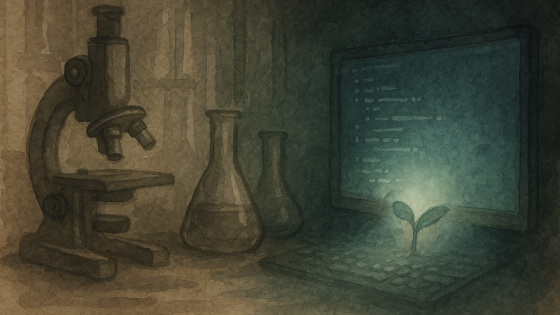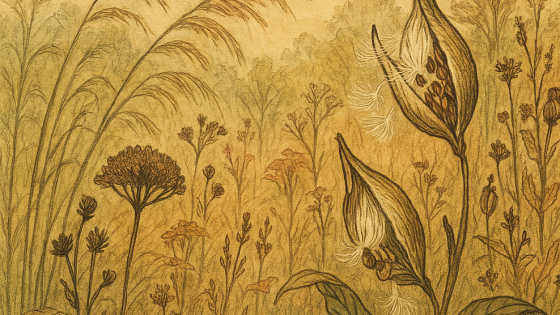Gather Close: The Secret Builders Inside Every Plant

Discover the hidden world inside every leaf. How plant cells build, grow, and thrive, thanks to the unsung hero molecule, callose.
Gather Close: The Secret Builders Inside Every Leaf
Settle in and let me tell you a story most people never hear. A story that unfolds in every patch of grass, every tree, every living green thing you’ve ever seen.
Have you ever wondered what’s really going on inside a leaf, or beneath the skin of a blade of grass? Imagine, just for a moment, shrinking down, down, smaller than a grain of sand, smaller than a speck of dust, until you’re the size of a single plant cell. Now, peer inside. What you’d find is a world more dramatic and ingenious than any tale told on this earth. It’s a place where tiny builders work in perfect harmony, crafting the green world all around us.
The Silent Symphony
In this secret world, something extraordinary is always happening. Something not cold or mechanical, but alive, intentional, a silent symphony of teamwork and timing. Picture a dance, not rigid like a marching band, but loose and lively like jazz. Each cell knows its part, improvising but always in step with its neighbors.
Now, here’s where the story gets good. Unlike animal cells, which can simply pinch themselves in two, plant cells are boxed in by tough, sturdy walls. They can’t just split apart. So, what do they do instead? They build something new. Right in the middle of the cell, they construct a brand-new wall, from scratch.
Picture a crew of builders showing up with their tools and materials, setting up scaffolding right in the center of a room, and slowly dividing the space into two. That’s what happens during a stage called cytokinesis, the final act of cell division in plants.
The Magic of Callose: The Plant’s Construction Tape
Here’s a secret that few ever notice: in this construction project, there’s a helper that doesn’t get much attention, but without it, the whole thing would fall apart. Its name is callose.
Callose is the plant’s version of construction tape. When a new wall is being built, callose rushes in first, holding everything together while the sturdier materials are on their way. It doesn’t stay long, but without it, the cell’s new wall would collapse before it had a chance.
Day after day, hour after hour, this humble molecule appears and disappears under the microscope, patching, supporting, sometimes even acting as a gatekeeper, letting messages and nutrients pass between cells. It arrives at just the right moment, does its job, and then vanishes, leaving behind a stronger, more resilient plant cell.

The “Aha!” Moment
Let me share a secret, one I learned after years of peering into this tiny world. Some people chase after the flashiest discoveries.
Me? I spent years studying this one humble molecule.
Why? Because day after day, I watched callose appear and disappear under my microscope, patching, supporting, sometimes even acting as a gatekeeper, letting messages and nutrients pass between cells. One molecule was making such a broad impact.
My research became a deep dive into this hidden choreography: how callose would arrive at just the right moment, do its job, and then vanish, leaving behind a stronger, more resilient plant cell.
For me, this was more than data points. It was a revelation, a glimpse into how plants engineer stability in a world of constant change, only ever making a stronger cell behind itself. What a lesson!
The Science Behind the Story
Let’s pull back the curtain for a moment. Callose is a polysaccharide, a chain of sugar molecules. When a plant cell divides, the new wall is fragile. Callose is laid down in thick layers, acting as a temporary brace. This gives the cell time to bring in stronger materials, like cellulose, to finish the job. And when the wall is ready, callose quietly dissolves away, as if the plant knows exactly when to let go.
But callose isn’t just a builder. In some plants, it helps regulate the flow of nutrients and signals between cells, opening and closing tiny channels called plasmodesmata. It’s a builder, a patch kit, and a gatekeeper, all rolled into one.

Growth, Movement, and the Dance of Life
Here’s the real magic: plants may seem still, but they’re always in motion. They bend toward sunlight, unfurl new leaves, heal after a storm. For all this to happen, their cells must be both strong and flexible, able to coordinate their growth and reinforce their connections.
Callose is the quiet hero in this dance, providing support during rapid growth, sealing wounds, helping cells talk to each other. It’s the backstage crew making sure the show goes on, even when no one’s watching.
Why This Matters
Now, you might ask, “Why should this matter?” Here’s why: understanding these tiny construction projects gives us the tools to shape a better future. By learning how plants build and rebuild themselves, we can help create crops that survive drought and disease, restore damaged lands, and help nature heal itself.
So next time you see a leaf unfurling or a seedling pushing through the soil, remember: there’s a team of microscopic builders, following blueprints millions of years in the making. It’s not just science, nature’s quiet magic, unfolding all around us.
Now, look at every green thing with new eyes, knowing there’s a whole world of stories happening just beneath the surface.
Want to learn even more?! Watch the Less than 3 Min educational video. How Plant Cells Divide (Cytokinesis)
I collaborated with an amazing team to bring plant cytokinesis to life for the first time in an educational and biologically accurate animation!
![Schematic representation of cytokinesis, summarizing cell plate formation. Still image excerpt from Video S1, S2. MT (microtubules). TGN (trans-Golgi network). Scale bar represents 1 μm. [Colour figure can be viewed at wileyonlinelibrary.com]](https://s3.us-east-1.amazonaws.com/contents.newzenler.com/49341/library/feb214426-fig-0001-m6855f7038b296_lg.png)
References:
- Sinclair, R., Wang, M., Jawaid, M. Z., Longkumer, T., Aaron, J., Rossetti, B., Wait, E., McDonald, K., Cox, D., Heddleston, J., Wilkop, T., & Drakakaki, G. (2024). Four-dimensional quantitative analysis of cell plate development using lattice light sheet microscopy identifies robust transition points between growth phases. Journal of Experimental Botany, 75(10), 2829–2847. https://doi.org/10.1093/jxb/erae091
- Sinclair, R., Chang, M., & Drakakaki, G. (2023). Cytokinesis and the formation of a new cell wall. In A. Geitmann (Ed.), Plant cell walls: Research milestones and conceptual insights (pp. 482–503). CRC Press. https://doi.org/10.1201/9781003178309-25
- Sinclair, R., Hsu, G., Davis, D., Chang, M., Rosquete, M., Iwasa, J.H. and Drakakaki, G. (2022). Plant cytokinesis and the construction of new cell wall. FEBS Letters, 596, 2243-2255. https://doi.org/10.1002/1873-3468.14426
- Cosgrove, D. J. (2005). Growth of the plant cell wall. Nature Reviews Molecular Cell Biology, 6(11), 850–861. https://doi.org/10.1038/nrm1746
- Rao, X., Bartley, L. E., Drakakaki, G., & Anderson, C. T. (2020). Editorial: Regulation of and by the Plant Cell Wall. Frontiers in Plant Science, 11, 513. https://doi.org/10.3389/fpls.2020.00513
Categories: : All, plant structure, Cellular
 Rosalie Sinclair
Rosalie Sinclair 



